Response To Demand Letter
[Your Name]
[Your Address]
[City, State, Zip Code]
[Email Address]
[Phone Number]
[Date]
[Recipient's Name]
[Recipient's Address]
[City, State, Zip Code]
Re: Response to Demand Letter
Dear [Recipient's Name],
I hope this letter finds you well. I am writing in response to the demand letter dated [Date of Demand Letter] that I received from you. I have carefully reviewed the content of your letter and the concerns raised, and I appreciate your willingness to communicate and seek resolution.
First and foremost, I want to assure you that I take this matter seriously and acknowledge the issues you have brought to my attention. I understand that your intent in sending the demand letter is to protect your rights and seek appropriate remedies.
To address the points raised in your demand letter:
[1. State the specific demands made in the letter and address each one individually.]
It is essential for both parties to find a fair and amicable resolution to this matter. I am open to engaging in further discussions to explore potential solutions. I believe that a constructive dialogue can help us reach an agreement that is satisfactory to both of us.
Please be assured that I am committed to resolving this matter promptly and in good faith. However, I must also emphasize that it is essential to consider the full context of the situation and any relevant circumstances that may have contributed to the current situation.
I kindly request that you provide any additional information or documentation that may help in understanding the issue better. Likewise, I am prepared to provide any necessary information or evidence to facilitate a comprehensive resolution process.
I propose that we consider alternative dispute resolution methods, such as mediation or negotiation, to reach an agreement without resorting to formal legal action. These approaches can often be more cost-effective and time-efficient, fostering a cooperative atmosphere that benefits both parties.
I am open to setting up a meeting or conference call at a mutually convenient time to discuss this matter further. Please let me know your availability, and I will make every effort to accommodate your schedule.
In the meantime, I would appreciate your patience while we work towards a resolution. Rest assured that I am actively taking steps to address your concerns, and I value your cooperation in this process.
Thank you for bringing this matter to my attention, and I look forward to hearing from you soon to begin the process of resolving this dispute.
Sincerely,
[Your Name]
Professional Response to Demand Letter
Subject: Response to Your Demand Letter Dated [Date]
Dear [Sender Name],
I am writing in response to your demand letter received on [Date]. After reviewing the matter thoroughly, I would like to address the points you raised and clarify my position.
[Provide clear explanation of your stance, any supporting facts, and any counterclaims if applicable.]
I am open to resolving this matter amicably and request that we discuss potential solutions. Please contact me at [Contact Information] to arrange a suitable time.
Sincerely,
[Your Name]
Formal Legal Response to Demand Letter
Subject: Formal Response to Demand Letter
Dear [Attorney/Sender Name],
I acknowledge receipt of your demand letter dated [Date]. After consultation with my legal counsel, I must respectfully deny the claims stated in your correspondence due to [Reason, e.g., factual inaccuracies or contractual interpretation].
I request that any further communication be conducted through legal representatives. I am prepared to provide necessary documentation and evidence to support my position.
Sincerely,
[Your Name]
Casual Email Response to Demand Letter
Hi [Sender Name],
Thanks for your letter dated [Date]. I wanted to let you know that I have reviewed your concerns and here’s my perspective: [Briefly explain your position or actions].
I hope we can work together to resolve this situation. Please let me know if you’d like to set up a call to discuss further.
Best regards,
[Your Name]
Preliminary Response to Demand Letter
Subject: Preliminary Response to Your Letter
Dear [Sender Name],
I have received your demand letter dated [Date] and am currently reviewing the matter in detail. This is a preliminary response to acknowledge receipt and indicate that I am considering the points raised.
A comprehensive reply will follow once all relevant information has been gathered. Thank you for your patience.
Sincerely,
[Your Name]
Heartfelt Response to Demand Letter
Subject: Response to Your Letter
Dear [Sender Name],
I received your letter dated [Date] and wanted to address it personally. I understand your concerns and the impact this matter has caused.
I assure you that I am committed to finding a fair and amicable resolution. Please let me know a convenient time to discuss possible solutions.
Warm regards,
[Your Name]
Quick Acknowledgment Response to Demand Letter
Subject: Acknowledgment of Demand Letter
Dear [Sender Name],
This is to acknowledge receipt of your demand letter dated [Date]. I am reviewing the contents and will respond in detail shortly.
Thank you for your attention.
Sincerely,
[Your Name]
Serious Legal Rebuttal to Demand Letter
Subject: Rebuttal to Demand Letter
Dear [Sender Name],
I am responding to your demand letter dated [Date]. After thorough review, I categorically deny the claims presented. The facts indicate [briefly state counter-facts or legal position].
I advise that any further correspondence be directed through my legal counsel to prevent miscommunication or escalation.
Sincerely,
[Your Name]
Informal Friendly Response to Demand Letter
Hi [Sender Name],
I got your letter from [Date]. I understand your points, and I think we can figure out a solution together.
Let’s chat soon to sort this out in a way that works for both of us.
Cheers,
[Your Name]
What is a Response to Demand Letter and Why It Is Needed
A Response to a Demand Letter is a formal reply to a communication requesting action, payment, or compliance.
Purpose includes:
- Documenting your position regarding the claims.
- Preventing misunderstandings or unnecessary escalation.
- Providing evidence of good faith in resolving disputes.
- Complying with legal or contractual obligations to respond within a certain timeframe.
Who Should Send a Response to a Demand Letter
- Individuals receiving a demand for payment or action.
- Businesses or organizations addressed in demand letters.
- Legal representatives replying on behalf of a client.
- Anyone needing to formally dispute or negotiate claims.
Whom Should Receive the Response to a Demand Letter
- The sender of the original demand letter.
- Legal counsel representing the sender.
- Relevant authorities if the letter is part of a legal or regulatory process.
- Mediators or arbitrators in cases of dispute resolution.
When to Send a Response to a Demand Letter
- Immediately upon receipt to acknowledge and document response.
- Within the legally required timeframe (often 7–30 days).
- When disputing, negotiating, or partially accepting claims.
- To prevent escalation to court or formal proceedings.
How to Write and Send a Response to a Demand Letter
- Carefully review the original demand and supporting evidence.
- Determine the facts, legal obligations, and possible counterclaims.
- Choose a tone appropriate to the situation: formal, professional, or informal.
- Outline your position clearly with supporting details.
- Offer solutions or request clarification if needed.
- Send via traceable methods (certified mail or email with read receipt) for documentation.
Requirements and Prerequisites Before Sending
- Full understanding of the original demand and supporting documents.
- Legal consultation if necessary.
- Accurate factual and financial records.
- Clear objectives: dispute, negotiate, or comply.
- Copies of all correspondence for record-keeping.
Elements and Structure of a Response to Demand Letter
- Subject line referencing the original demand letter.
- Greeting addressing the sender.
- Acknowledgment of receipt.
- Statement of your position (accept, dispute, partially accept).
- Supporting evidence or reasoning.
- Proposed resolution or next steps.
- Closing and contact information.
- Attachments: supporting documents, proofs, or evidence.
Formatting and Tone Guidelines
- Length: Usually 1–2 pages depending on complexity.
- Tone: Professional and respectful; serious for legal matters.
- Wording: Clear, precise, and factual.
- Mode: Printed letter for legal purposes; email for quick acknowledgment.
- Etiquette: Avoid inflammatory or emotional language; maintain objectivity.
After Sending / Follow-up Actions
- Confirm receipt of your response.
- Keep copies of all correspondence.
- Monitor for further communication, negotiation, or legal escalation.
- Document any agreements or settlements reached.
- Be prepared to provide additional evidence if requested.
Common Mistakes to Avoid
- Ignoring deadlines for responding.
- Using vague or ambiguous language.
- Providing incomplete or inaccurate information.
- Sending a casual or informal reply for legal matters.
- Failing to consult legal advice when necessary.
Tips and Best Practices
- Always acknowledge receipt even if a detailed response will follow.
- Organize facts and evidence clearly.
- Maintain professional tone at all times.
- Send responses via traceable methods.
- Consider offering negotiation or compromise to prevent escalation.
FAQ About Responses to Demand Letters
Q: Do I have to respond to a demand letter?
A: Yes, responding is critical to protect your rights and avoid default assumptions.
Q: Can I dispute the claims in a demand letter?
A: Absolutely, and your response should clearly outline your counterarguments or evidence.
Q: Should I involve a lawyer?
A: It is recommended if the matter involves legal or financial risk.
Q: How long do I have to respond?
A: Typically within 7–30 days, depending on the demand and applicable laws.
Q: Can I settle or negotiate through my response?
A: Yes, proposing settlement or compromise is common and can prevent escalation.

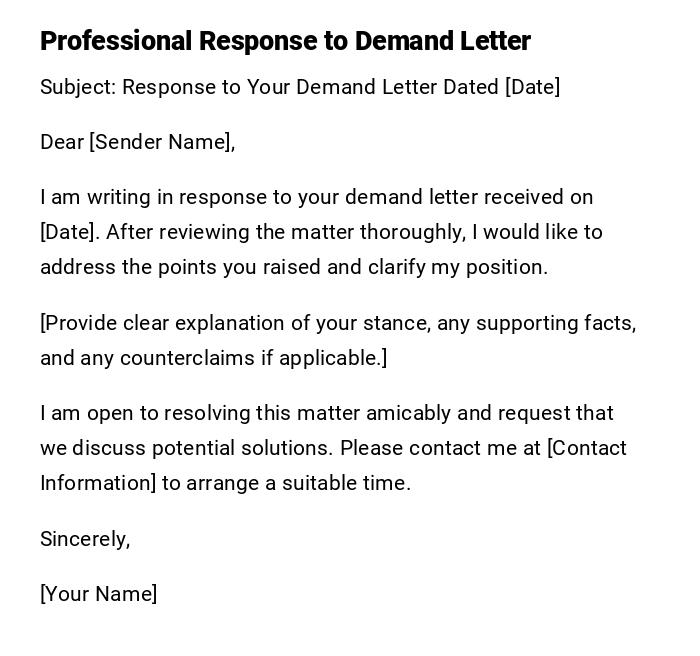
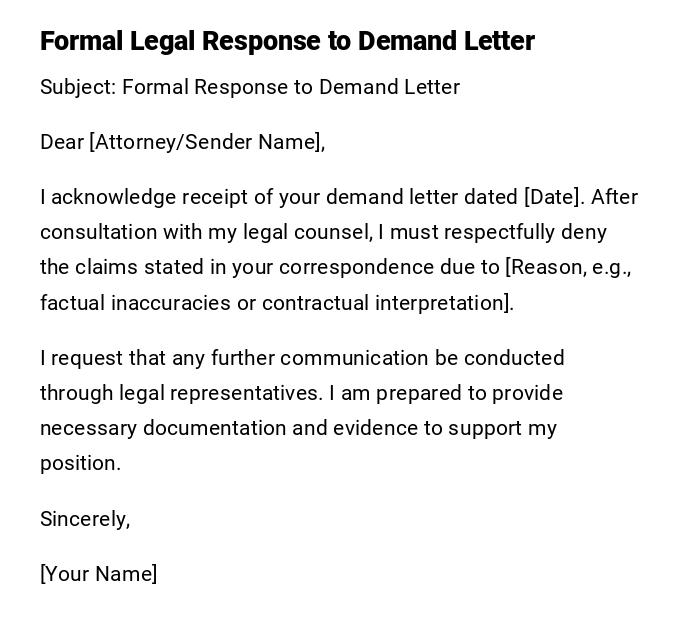
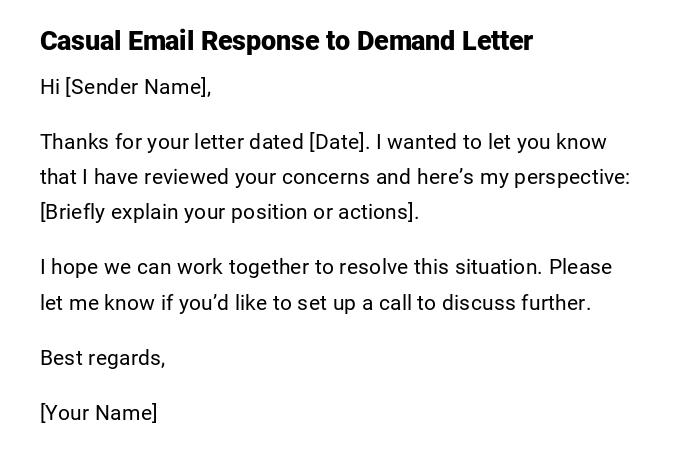
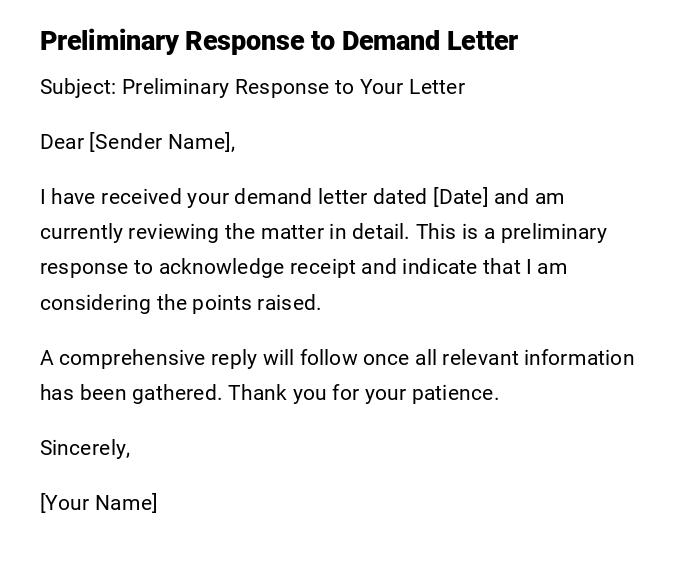
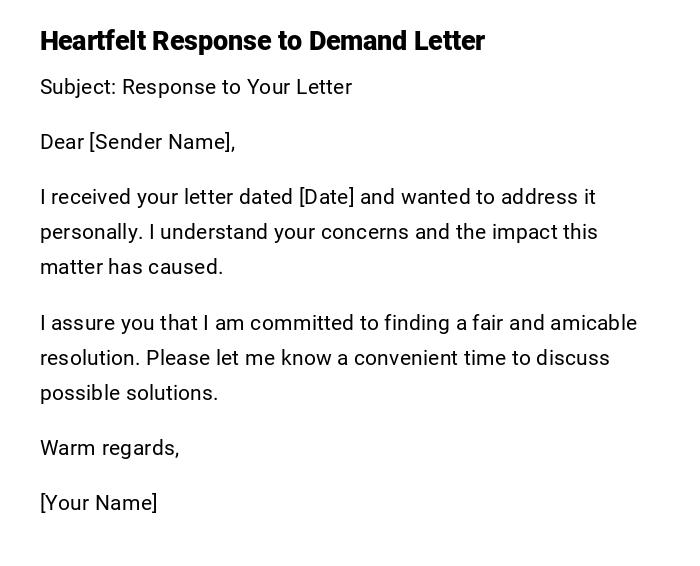
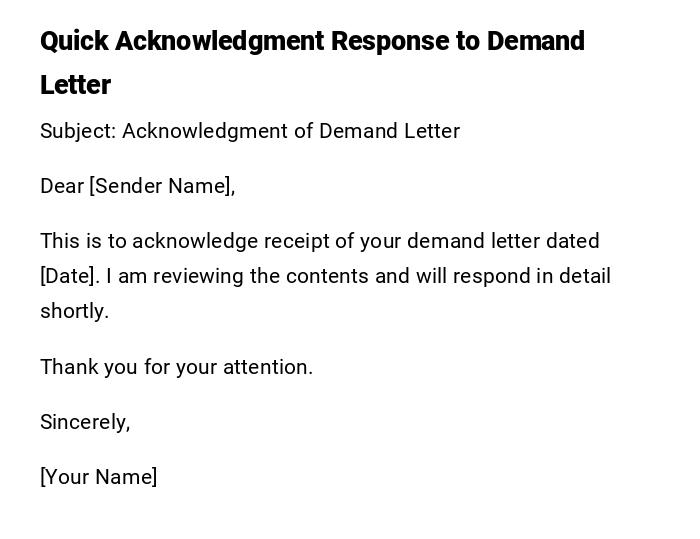
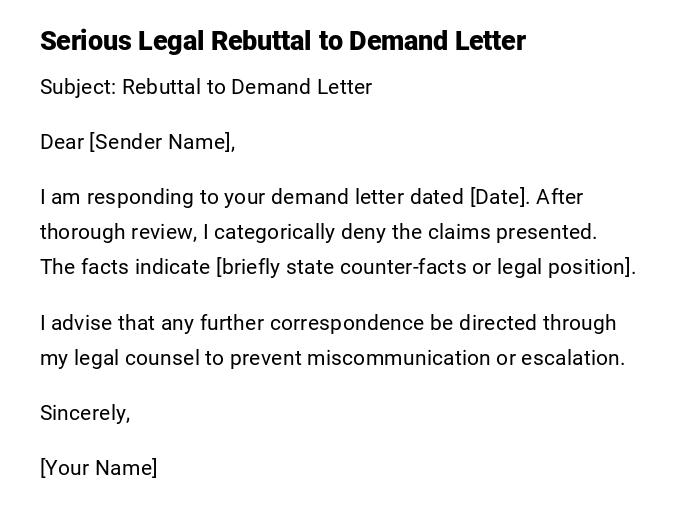
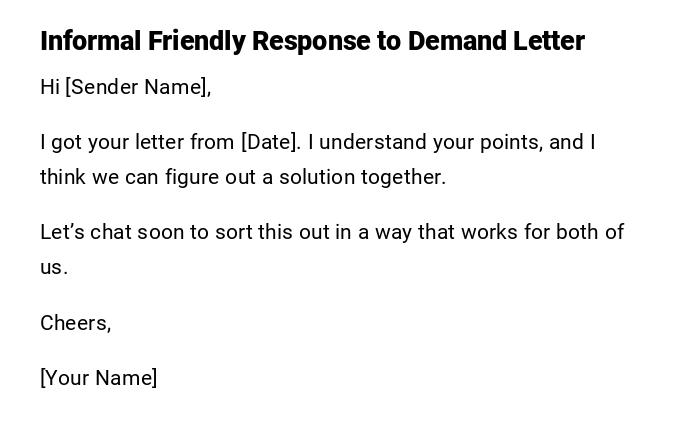

 Download Word Doc
Download Word Doc
 Download PDF
Download PDF